LIFE Instructional Matrix® (LIM)

Every lesson plan developed by LIFE is structured based on our proprietary LIFE Instructional Matrix®. Each class will feature at least one component from each of the five instructional pillars of LIFE.
- All classes will be conducted in one or more of the 7 expressive mediums. For example, some classes will feature Music and Dance, while others will be focused on Speech and Writing.
- All classes will feature instructional content from one of the 7 Learning Content categories. This content will be aligned to seasons, festivals and other occasions as appropriate.
- All classes will provide some degree of focus on one or more of the Literacy and Numeracy skills. This will ensure a gradual build-up of these skills while applying them in different contexts.
- All classes will provide some degree of focus on one or more of the Physical and Motor Development categories. This will ensure constant physical activity and variation in mediums.
- All classes will reiterate certain aspects of the Social and Emotional Development categories to ensure that the students are receiving a well-rounded instructional experience.
Each of the instructional pillars have been detailed below. Please review this information for a thorough understanding of the structure and its logic.
LIM Pillar I - Expressive Medium
This pillar looks at different mediums that children might use to communicate their thoughts and ideas. While the children will be exposed to all these mediums, they are not expected to excel equally in all of them, but to have a balanced average score cumulatively for the Expressive Medium pillar.
The mediums included in this pillar are:
- Speech: Verbal communication in the medium of instruction (English / Hindi / Marathi as appropriate)
- Writing: Ability to write legibly and construct coherent communication in the written medium
- Music: Aptitude to sing or play music through a musical instrument
- Dance: Aptitude to dance (as instructed or freestyle)
- Theatre: Ability to act and emote with expressions, gestures and / or body language
- Drawing / Painting: Ability to draw or sketch and paint with any of the provided drawing implements
- Sculpting: Ability to work with modeling clay and sculpt
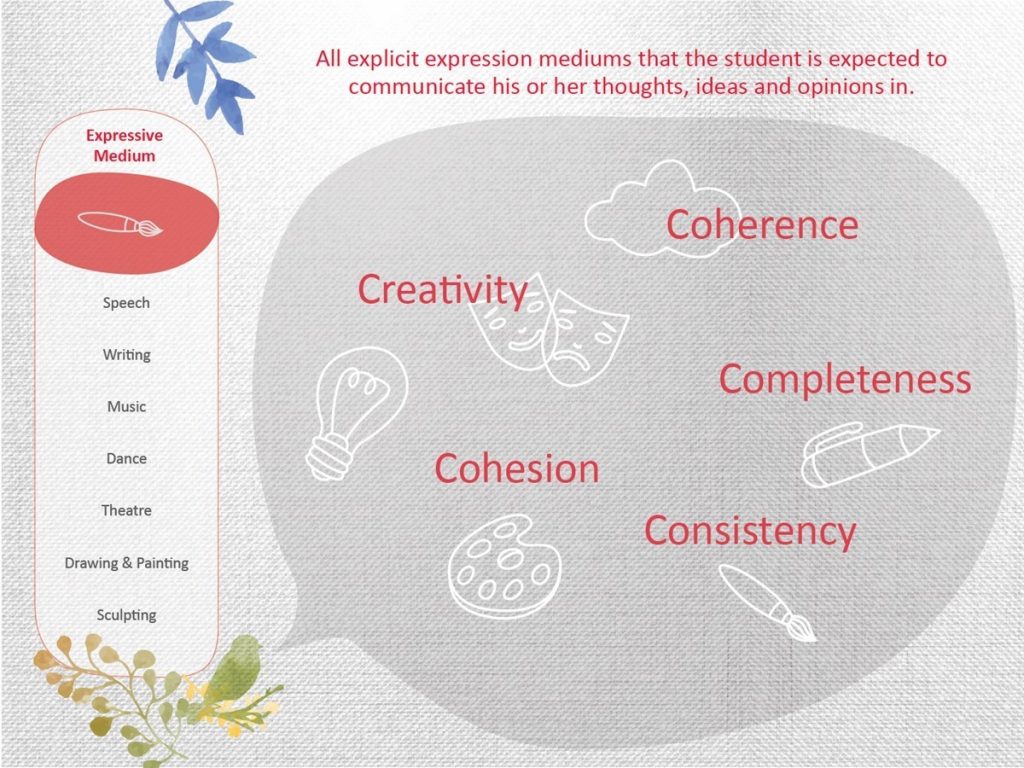
This pillar encompasses all the explicit expression mediums that the student is expected to communicate his or her thoughts, ideas and opinions. The overall developmental outcomes expected from this column are based on the 5 Cs of Expression.
- Creativity: How original and unique is the child's imagination?
- Coherence: How easy is it to understand the child's expression?
- Cohesion: How well are the child's thoughts and ideas linked together?
- Consistency: Does the child manage to invest the same degree fo effort and energy throughout?
- Completeness: Does the child manage to complete the exercise in expression?
For the early education curriculum, the Learning Content pillar has seven key areas. These are:
- Family & Friends: This is one of the basic learning content modules. It covers relationships with the family as well as with friends. The involvement of the family is critical in this piece to ensure that the child is able to correlate concepts to his or her family
- Animals & Plants: This module is used to introduce the concept of animals and plants to the children. It is important to correlate pets in the house as well as gardens to the children, as well as introduce these concepts through real examples in the classroom
- Food & Drink: This module provides a thorough understanding of food and drink as an essential part of life. Concepts such as a balanced diet and the effects of food are covered right from this point
- Travel & Transport: This module discusses the different modes of transport used to travel within the city or for longer distances. Each mode of transport is discussed through real examples (where possible) or through audio-visual media
- Seasons & Festivals: Lessons from this module will be interspersed as applicable based on when the seasons and festivals occur in the annual curriculum. This will allow teachers to actually demonstrate real examples for each of the lessons in the world around them
- Entertainment: An important part of the curriculum is to introduce children to the concept of entertainment and being able to regulate themselves with entertainment. This will involve actually exposing them to popular media and entertainment in a structured manner
- Objects Around Us: This module is used to address regular daily objects in the world around us. This will be used to introduce sundry objects and concepts that children need to know, including objects in the classroom or in various rooms in the house
LIM Pillar II - Learning Content
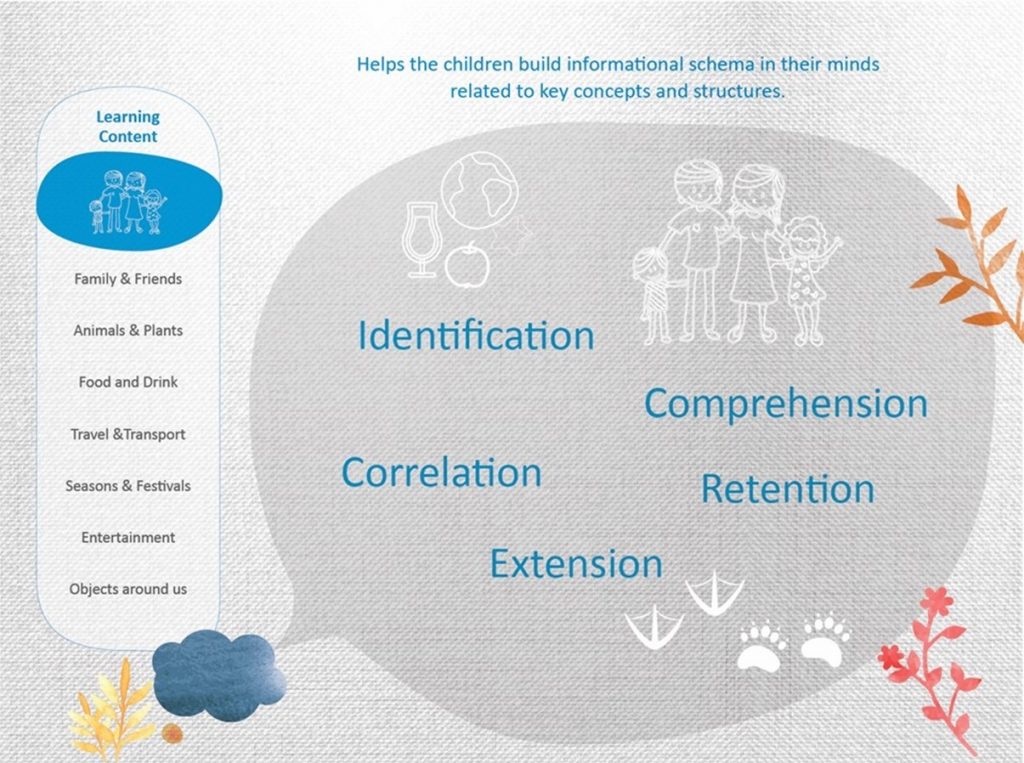
This pillar provides all the base content that is part of the instructional experience. This pillar is important as it helps the children build informational schema in their minds related to key concepts and structures. The overall development of the child in this pillar is based on the following key concepts:
- Identification: The child should be able to identify each of the key concepts taught through the physical world or visual media. All elements must be identified through actual examples or at least images or videos
- Comprehension: The child must understand the concept in connection to his or her life or other related concepts taught in the curriculum
- Correlation: The child must be able to connect concepts and understand the relationship between linked concepts
- Retention: The child must be able to remember key concepts and use these concepts in the correct context at a later point in time
- Extension: The child must be able to extend the content they learned in class by linking it to their own experiences at home or outside and learning from these experiences
LIM Pillar III - Literacy & Numeracy
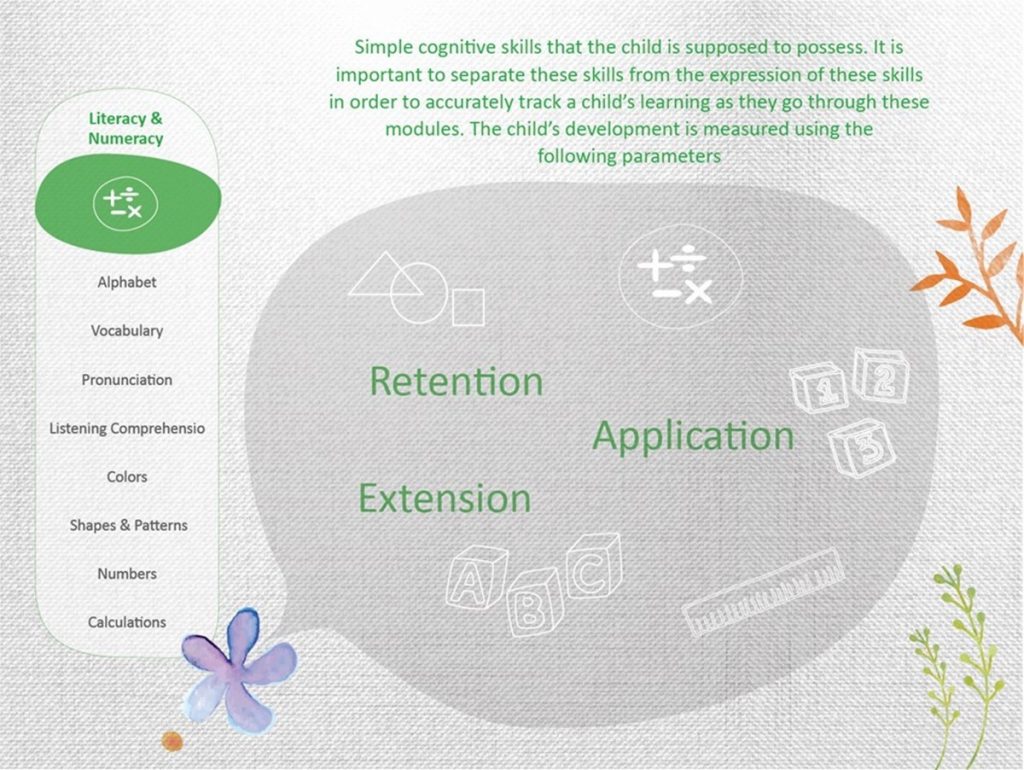
The components included in this pillar are:
- Alphabet: Ability to recite, identify and reproduce the letters of the alphabet
- Vocabulary: Ability to recall and use words taught in class as a natural part of their own vocabulary
- Pronunciation: Ability to clearly pronounce and enunciate the words as taught in class
- Listening Comprehension: Ability to listen to spoken content and comprehend the essence
- Shapes & Patterns: Ability to identify shapes and spot patterns
- Numbers: Ability to remember the number system and use it to count
- Calculations: Ability to conduct simple mathematical operations
This pillar deals with simple cognitive skills that the child is supposed to possess. It is important to separate these skills from the expression of these skills in order to accurately track a child’s learning as they go through these modules. The child’s development in this pillar is measured using the following parameters:
- Retention: The child must be able to remember the taught concepts
- Application: The child must be able to apply the concepts in other contexts
- Extension: The child must be able to extend the concepts independently and carry them forward
The components included in this pillar are:
- Spatial Awareness: Ability to gauge height, depth and distance while navigating through various areas and engaging in activities
- Gross Motor Skills: Ability to develop the required gross motor skills in terms of walking, running and moving around while engaging in different activities
- Fine Motor Skills: Ability to develop fine motor skills required for various activities including eating, writing and working with intricate toys
- Motor Memory: Ability to automate certain gestures and movements till they become subconscious and don’t require independent effort
- Problem Solving: Ability to analyse and solve problems around a given physical space and physically manipulating different objects to achieve a goal
- Flexibility & Fitness: Ability to achieve and maintain the required degree of flexibility and fitness as required by various activities
- Awareness & Safety: Knowledge of the risks and dangers of heights, hard surfaces and sharp edges and how to use this knowledge to ensure own safety
LIM Pillar IV - Physical & Motor Development
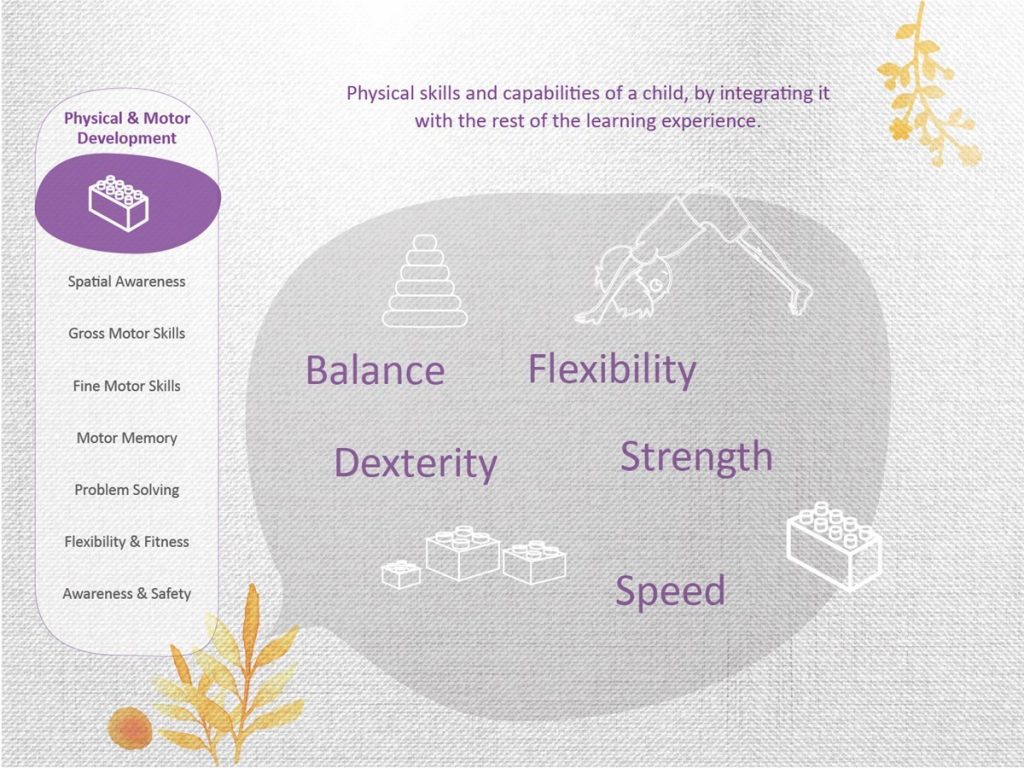
This pillar deals with the physical skills and capabilities of a child, by integrating it with the rest of the learning experience. It is important to integrate this component with all lessons to ensure that physical activity becomes a part of the learning experience. The child’s development for this component is based on the following parameters:
- Balance: The child is able to maintain balance through the assigned activities
- Flexibility: The child is able to demonstrate the required physical flexibility required for activities
- Strength: The child develops strength proportional to age and size to be able to participate in activities
- Speed: The child demonstrates sufficient speed in gross and fine motor skills based tasks
- Dexterity: The child demonstrates adequate delicacy and accuracy with fine motor skills
LIM Pillar V - Social & Emotional Development
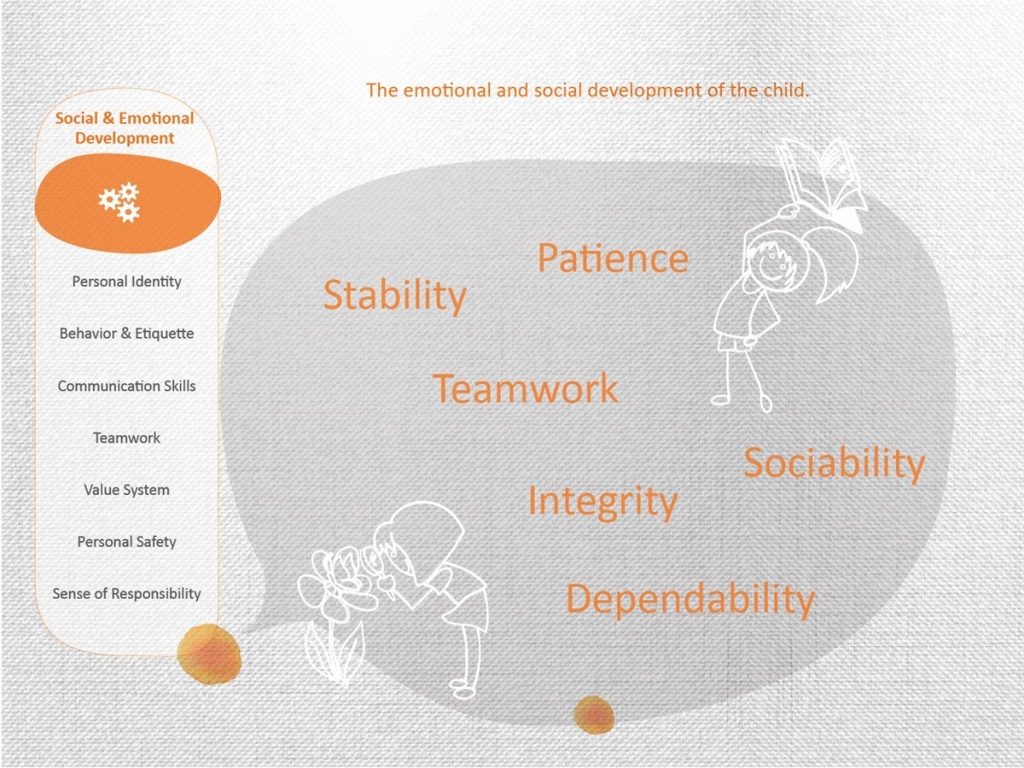
The components included in this pillar are:
- Personal Identity: The ability to introduce oneself while providing relevant information as and when required
- Behavior & Etiquette: The ability to identify what is appropriate behaviour in different social contexts and how to behave accordingly
- Communication Skills: The ability to communicate open and clearly with various people
- Teamwork: The ability to work as an effective part of a team
- Value System: A well-grounded set of values based on honesty and empathy towards everyone
- Personal Safety: The ability to be able to identify people who behave inappropriately and knowing what to do in situations where the child is at risk
- Sense of Responsibility: The knowledge of the concept of being responsible is and how to fulfil responsibility at the cost of personal priorities
This pillar deals with the emotional and social development of the child. It is critical to ensure well-rounded emotional development by integrating this aspect into the regular lessons and curriculum. The child’s development for this component is based on the following parameters:
- Stability: The child demonstrates the required level of emotional and temperamental stability
- Patience: The child shows patience and persistence with activities that require focused attention
- Integrity: The child demonstrates honesty, truthfulness and overall integrity in its behaviour
- Sociability: The child is open and extroverted and makes friends easily
- Teamwork: The child works well in groups and team activities, with the ability to contribute to the group’s overall goals while keeping aside own goals
- Dependability: The child inspires a feeling of trust in other children and in teachers
Alignment of our Lesson plans with LIM
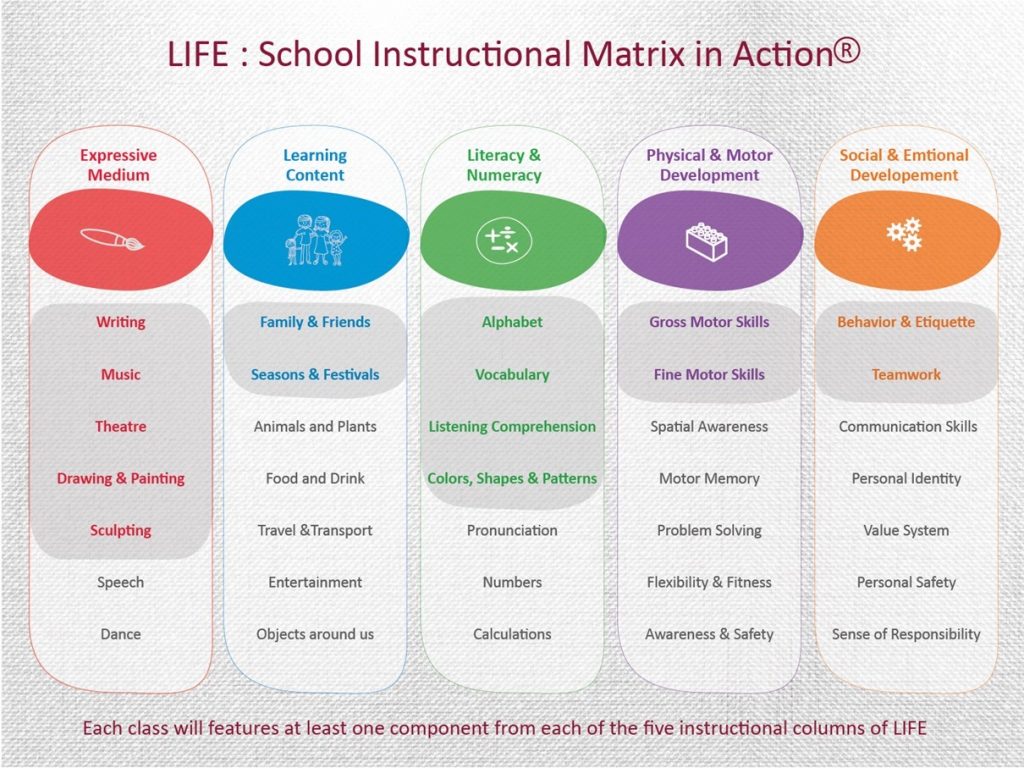
Each of our lesson plans mentions the areas of LIFE Instructional Matrix covered within it. All our lesson plans taken in entirety cover all areas of the LIM, thereby ensuring holistic development of children.
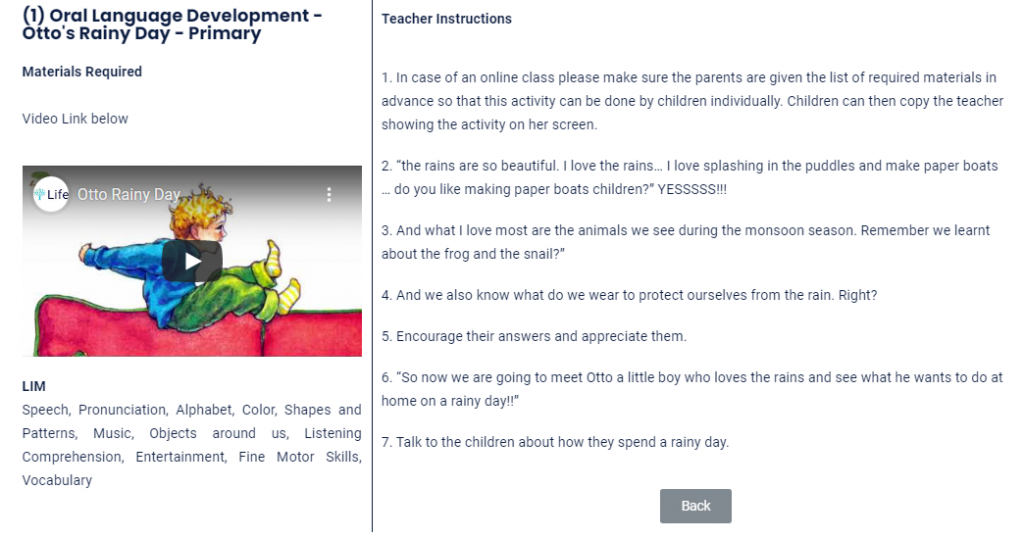
Here’s an example of our lesson plans. LIM areas are clearly mentioned in each lesson plan apart from material required, video / audio resources and detailed teacher instructions.
